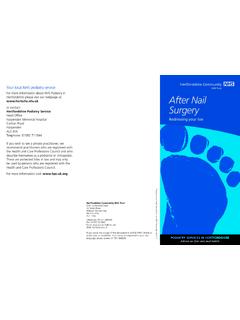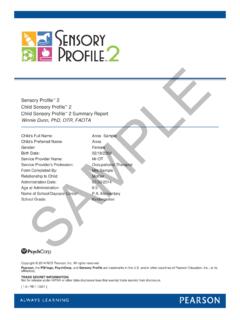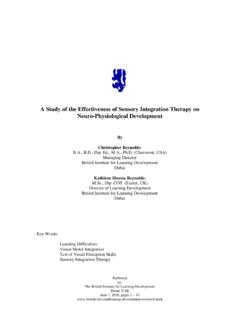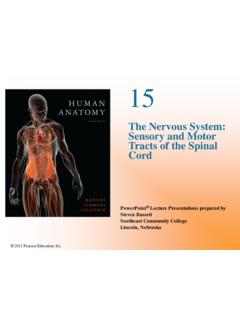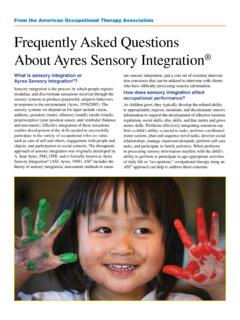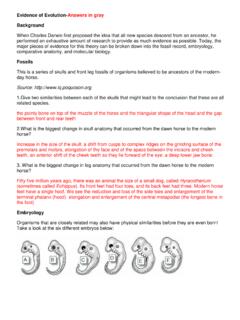Transcription of Basic Sensory Diet information and activity ideas for self ...
1 Basic Sensory Diet information and activity ideas for self-isolation and social distancing A Sensory diet is Sensory based activities that are planned throughout the day with the aim of you child regulating him/herself and being calm and alert so they can engage in the activities of the day. We all use Sensory strategies to help us cope with stressful situations. For example, many of us may display some Sensory based behaviours when nervous when going for a job interview. Going for a swim or a run on the morning of this occasion may help in reducing stress, going for a swim the night before may help in having a better night s sleep.
2 Practising interview questions before the interview is kind of like a social story. Having some sort of reward afterwards. We can also put some strategies in to place within the interview clasping our hands tightly, having a drink to hand, taking a pen and paper in as a fidget toy, crossing our legs and arms to gain proprioception. A Sensory diet is not a reward; it is an essential part of a child s day. For example, think about why we eat breakfast would breakfast be a good reward if you have done well at school? A Sensory diet consists of: Main Courses Breakfast, lunch and dinner - longer periods of structured movement, deep pressure and heavy work.
3 Snacks brief activities for completing at desk, during lessons, when anxious. What are the problems with going on a diet? Sticking to it. Initial motivation can dwindle. Highlight a few activities and stick to those around key times of difficulty during the day. Examples of Sensory diets in action: Monitoring your child will help in thinking through peak times of difficulty for him/her and when he/she may need Sensory strategies to help him/her cope throughout his/her day. For example: o Change / transitions. o Social situations.
4 O Difficulty planning out of a situation. o Demands of the situation. o Fatigue / time spent in that environment. o Previous experiences that day. o Personal care. When putting together a Sensory diet for your child it is important to observe what he/she is doing is he/she providing ideas about what he/she needs or what he/she is seeking. Monitor the effectiveness of the Sensory diet on your child and make changes as required. Have a Sensory diet recipe file. o Sometimes you want something new and exciting; sometimes you crave something comforting and familiar.
5 O Involve your child in choosing things for his/her Sensory diet. Proactively your child s Sensory needs either before, after or within an activity or all three. Movement breaks as part of a Sensory diet should be completed regularly. Factors to improve and develop a Sensory diet: o Monitor record behaviour changes and any improvements seen in either the activity you want your child to do, or reducing the behaviour that you don t want to see. o Consider intensity of activity . o Consider the duration of an activity . o This is a trial and error approach not a prescription.
6 Time and frequency: Implementation of the diet should be completed at regular intervals throughout the day. For example: Breakfast > Snack > Lunch > Snack > Dinner > Snack OR Before, during and after functional tasks A timer can be used alongside a visual schedule or now and next chart to indicate what activities your child is expected to participate in. For example, completing a therapy ball task for 10 minutes followed by a 10 minute fine motor task, with a short movement break for 2 minutes, in the middle of the fine motor task and followed by a 10 minute play on a trampoline.
7 A now and next visual timetable would be appropriate to use to implement both the Sensory diet and fine/gross motor activites. REMEMBER: Your child may require snacks during tasks and activities therefore it is important to monitor his/her responses and act on them. Environmental factors The environment in which your child is in should be taken into consideration as part of his/her Sensory diet. It is important to consider the following that may have an impact: Busy/cluttered walls. Background noise. Lighting. Physical layout of the room.
8 Consistency/predictability if the visual environment. The environment should aim to support your child in knowing what to attend to and what is required for the task at hand. Having structure within the environment so that there is order can be helpful when implementing Sensory diets. Calming and alerting activities: Proprioception provides us with information regarding: Our awareness of body position. Knowing where our body parts are in space and in relation to each other. Timing and force needed for activities. Can have calming, organizing and focusing benefits.
9 Can be used as wake up exercises. Proprioception can be both calming and alerting to the nervous system and is the go to tool for Sensory diet activites for any child. You child may present in different ways. Your child can try any of the following activities. These can be incorporated at home as either Sensory main courses or Sensory snacks: Lifting books and toys back onto shelves. Helping with chores around the home washing up, filling/emptying a dishwasher, hoovering, dusting. Lying on tummy on the floor to watch TV this is a good anti-gravity position and gives heavy work to a lot of muscles!
10 Taking bags of rubbish to the dustbin. Taking a dog for a walk with social distancing. Massage especially on the back. A warm bath with foam bubbles, pulling plungers off the bottom of the bath. A hot dog . The child lies down on a jumbo cushion or pillow (either on their front or back) and another cushion is placed on top (not on the face) and gentle firm pressure can be given by an adult in addition to the weight of the cushion (alternatively roll a ball/ space hopper on the child s back). Being rolled up tightly in a duvet cover or blanket.

